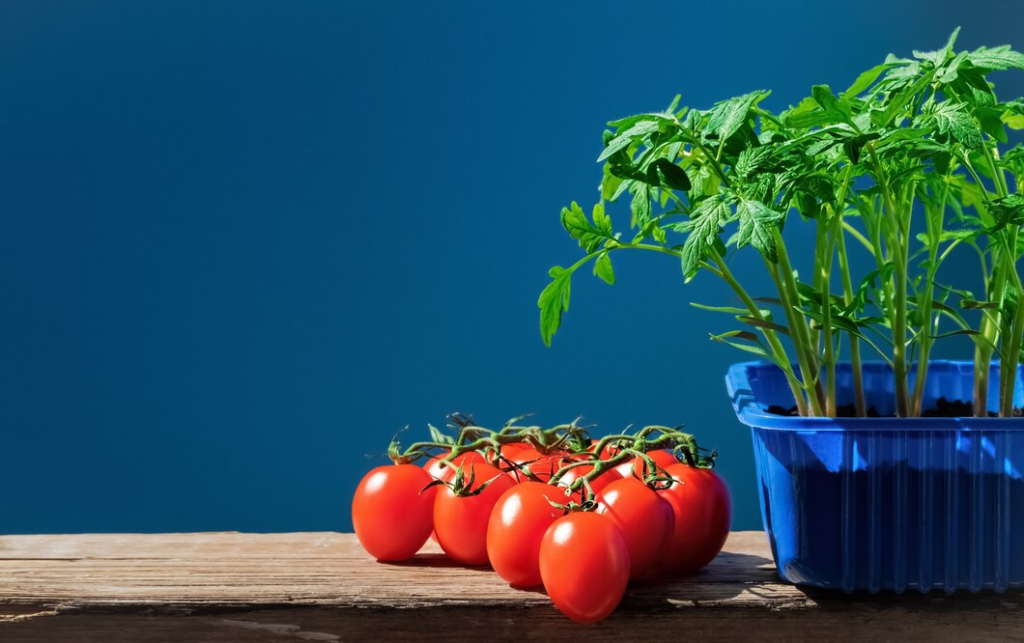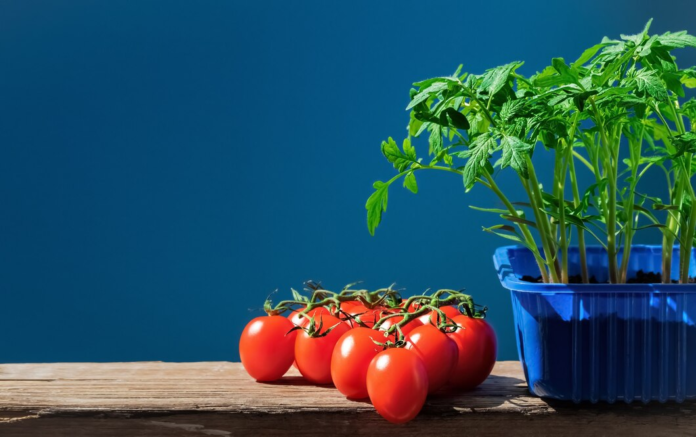Growing tomatoes indoors allows you to savor the delicious taste of homegrown tomatoes throughout the year. While traditionally considered outdoor crops, tomatoes can thrive in indoor environments with the right care and attention. In this guide, we’ll explore the steps and considerations for successfully cultivating tomatoes within the confines of your home.

Choosing the Right Tomato Varieties
When venturing into indoor tomato cultivation, the choice of tomato varieties plays a crucial role. Opt for compact and determinate varieties, which are better suited for container gardening and indoor spaces. Cherry tomatoes, patio tomatoes, or dwarf varieties like Tiny Tim are excellent choices for indoor cultivation.
Selecting the Ideal Containers
Choosing the right containers is essential for successful indoor tomato growing. Opt for large containers with good drainage to prevent waterlogged soil. Consider self-watering containers to maintain consistent moisture levels and minimize the risk of overwatering, a common challenge in indoor gardening.
Preparing the Growing Medium
Creating a well-balanced growing medium is vital for the health of your indoor tomato plants. Use a high-quality potting mix enriched with organic matter. You can also add perlite or vermiculite to improve drainage and aeration, ensuring optimal conditions for robust root development.
Providing Ample Sunlight
Tomatoes are sunlight-loving plants, so providing ample light is crucial for their indoor success. Place your containers near south or southwest-facing windows to maximize exposure to natural sunlight. If sunlight is limited, supplement it with full-spectrum LED grow lights, positioning them 12-18 inches above the tomato plants for optimal results.
Maintaining Appropriate Temperatures
Tomatoes thrive in moderate temperatures, ideally between 70-85°F (21-29°C) during the day and slightly cooler at night. Ensure a stable indoor environment to support healthy growth. Be cautious of exposing your tomatoes to drafts or extreme temperature fluctuations, as they can impact plant health.
Watering Consistently
Consistent and appropriate watering is crucial for indoor tomato plants. Keep the soil consistently moist but not waterlogged. Water when the top inch of soil feels dry to the touch, adjusting the frequency based on factors such as room temperature, humidity, and the size of your containers.
Feeding Your Tomato Plants
Tomatoes are nutrient-hungry plants, and providing them with the right nutrients is essential for productive growth. Use a balanced and water-soluble fertilizer, applying it according to the package instructions. Begin fertilizing when the plants start flowering, and continue throughout the growing season.
Pruning for Productivity
Regular pruning is key to maintaining the shape and productivity of your indoor tomato plants. Remove suckers – the small shoots that develop between the main stem and branches – to encourage better air circulation and channel energy towards fruit production. Additionally, remove any yellowing or diseased leaves promptly.
Supporting Tomato Plants
As your indoor tomatoes grow, providing support becomes crucial, especially when they start bearing fruit. Use stakes, cages, or trellises to support the plants and prevent sprawling. Proper support not only ensures healthier plants but also makes harvesting easier.
Hand Pollination
Indoor environments may lack natural pollinators, so assisting with pollination can enhance fruit production. Gently shake the plants or use a small brush to transfer pollen between flowers. This active measure helps ensure that your tomato plants set fruit successfully.
Managing Pests
While indoor environments generally reduce the risk of pests, occasional invaders like aphids or spider mites may appear. Regularly inspect your plants, especially the undersides of leaves, and address any pest issues promptly. Neem oil or insecticidal soap can be effective and safe solutions.
Harvesting the Bounty
The excitement of growing tomatoes indoors culminates in the joy of harvesting your homegrown tomatoes. Tomatoes are ready for harvest when they reach their full color, and the fruit feels firm but gives slightly when gently squeezed. Harvest regularly to encourage continuous fruiting.
Overcoming Challenges
Indoor tomato cultivation comes with its challenges, including the risk of fungal diseases and the need for active pollination. To address fungal issues, ensure good air circulation around your plants and practice proper spacing. Hand pollination or using an electric toothbrush to vibrate flowers can enhance pollination.
Experimenting with Varieties
Indoor tomato growing offers the opportunity to experiment with different varieties. Explore heirloom varieties, colorful tomatoes, or unique shapes to add diversity to your indoor garden. Each variety brings its own distinct flavor and visual appeal to your homegrown harvest.
Creating an Indoor Tomato Haven
Combine tomatoes with companion plants like basil or marigolds to create a thriving and aesthetically pleasing indoor garden. Companion planting can help deter pests and enhance the overall health of your tomato plants.
Sharing the Joy
Growing tomatoes indoors allows you to share the joy of homegrown produce with friends and family. Consider gifting potted tomato plants or a basket of freshly harvested tomatoes, spreading the delight of flavorful, homegrown goodness.
Conclusion
In conclusion, the answer to whether you can grow tomatoes indoors is a resounding yes. With careful consideration of varieties, containers, growing conditions, and proactive care, you can cultivate a flourishing tomato garden within the comfort of your home. Embrace the journey of nurturing these versatile plants, and relish the satisfaction of enjoying fresh, homegrown tomatoes regardless of the season.
Also read: Types of Indoor Palm Plants



